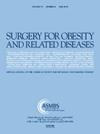Impact of same-day sleeve gastrectomy surgery on postoperative emergency department visits: analysis from the Michigan Bariatric Surgery Collaborative
IF 3.5
3区 医学
Q1 SURGERY
引用次数: 0
Abstract
Background
Same-day discharge after sleeve gastrectomy (SDDSG) is being performed in select patient populations with increased regularity since 2020.
Objectives
To evaluate the impact of SDDSG on emergency department (ED) visits.
Setting
Academic and private practice bariatric surgery programs participating in a statewide quality improvement collaborative.
Methods
Using a statewide bariatric specific data registry, all patients undergoing SDDSG between 2020 and 2023 were identified (n = 984). Rates of 30-day ED visits and complications were compared between SDDSG and a 2:1 propensity-matched cohort with a 1–2-day hospital length of stay (n = 1968).
Results
The mean age and body mass index of SDDSG patients were 41.7 years and 45.9, respectively. When compared to the matched cohort, SDDSG patients had higher rates of ED visits (9.2% versus 6.2%, P = .0029), were more likely to present to ED earlier (10.3 days versus 12.9 days, P = .0118), and were less likely to require hospital admission (87.8% versus 71.1%, P < .0037), even though the overall complication rates were similar (4.7% versus 3.7%, P = .2087). The most common reason for an ED visit after SDDSG was nausea, vomiting, and dehydration (58.9% versus 66.9%, P = .2294), and the most common day to present to the ED was Friday (20.0% versus 20.7%, P = .9061), which was similar between groups.
Conclusions
Despite having similar complication rates, patients undergoing SDDSG were more likely to present to the ED after surgery when compared to a matched cohort of patients with a 1–2-day hospital stay.

当日套筒胃切除术对术后急诊就诊的影响:来自密歇根减肥手术协作组的分析
背景:自2020年以来,在选择性患者群体中,套管胃切除术(SDDSG)术后同一天出院的频率增加。目的:评价SDDSG对急诊科(ED)就诊的影响。环境:学术和私人实践减肥手术项目参与全州范围内的质量改进合作。方法:使用全州范围内的特定肥胖数据登记处,确定所有在2020年至2023年期间接受sdsg的患者(n = 984)。比较sdddsg和2:1倾向匹配的住院时间为1-2天的队列患者30天急诊科就诊率和并发症(n = 1968)。结果:SDDSG患者的平均年龄为41.7岁,体重指数为45.9岁。与匹配的队列相比,SDDSG患者的ED就诊率更高(9.2%对6.2%,P = 0.0029),更有可能更早出现ED(10.3天对12.9天,P = 0.0118),并且更不可能需要住院(87.8%对71.1%,P < 0.0037),尽管总体并发症发生率相似(4.7%对3.7%,P = .2087)。SDDSG后最常见的急诊科就诊原因是恶心、呕吐和脱水(58.9%对66.9%,P = .2294),最常见的急诊科就诊日期是周五(20.0%对20.7%,P = .9061),两组之间相似。结论:尽管并发症发生率相似,但与住院1-2天的匹配队列患者相比,接受sdddsg的患者术后更有可能出现在急诊科。
本文章由计算机程序翻译,如有差异,请以英文原文为准。
求助全文
约1分钟内获得全文
求助全文
来源期刊
CiteScore
6.70
自引率
12.90%
发文量
570
审稿时长
56 days
期刊介绍:
Surgery for Obesity and Related Diseases (SOARD), The Official Journal of the American Society for Metabolic and Bariatric Surgery (ASMBS) and the Brazilian Society for Bariatric Surgery, is an international journal devoted to the publication of peer-reviewed manuscripts of the highest quality with objective data regarding techniques for the treatment of severe obesity. Articles document the effects of surgically induced weight loss on obesity physiological, psychiatric and social co-morbidities.

 求助内容:
求助内容: 应助结果提醒方式:
应助结果提醒方式:


